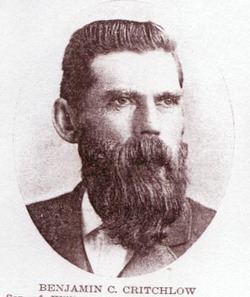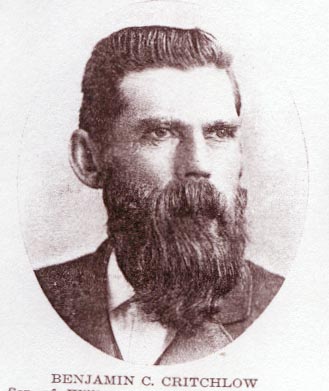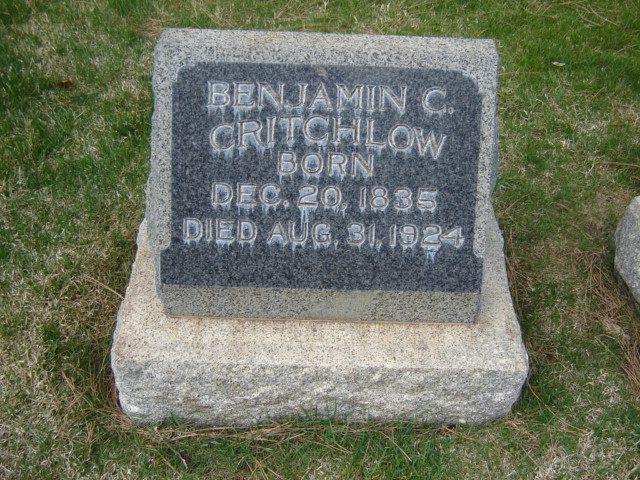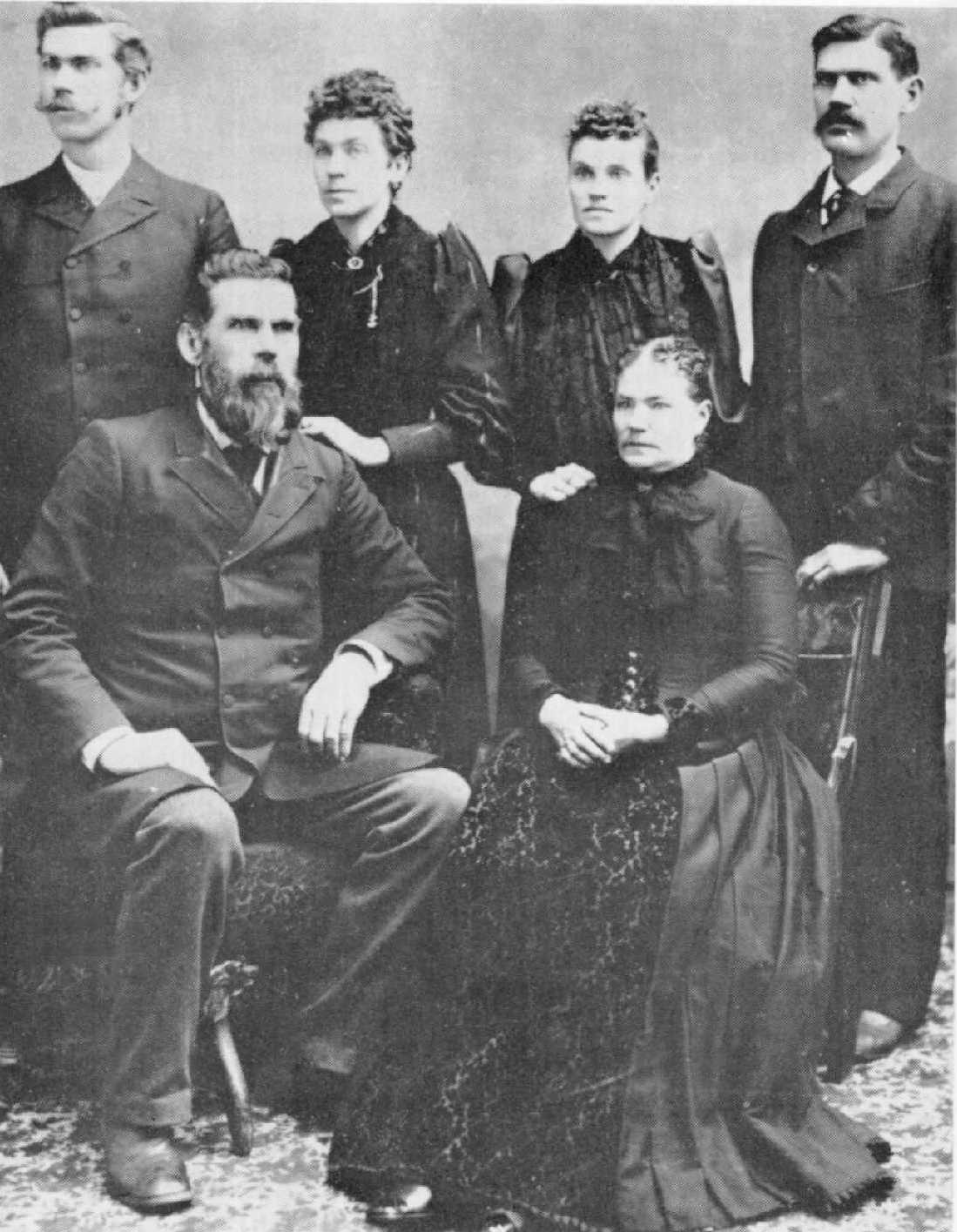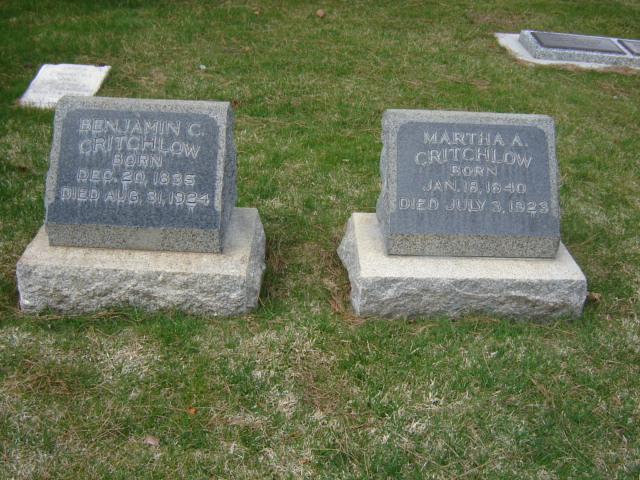Critchlow, Benjamin Chamberlin
Birth Date: 20 Dec 1835
Death Date: 31 Aug 1924
Gender: Male
Age: 15
Company: Harry Walton/Garden Grove Company (1851)
Pioneer Information:
son of William
Harry Walton/Garden Grove Company (1851)
Departure: 17 May 1851
Arrival: 24-25 September 1851
Company Information:
About 21 families from Garden Grove plus other individuals and 60 wagons were in the company when it began its journey from the outfitting post at Kanesville, Iowa (present day Council Bluffs). They left Garden Grove, Iowa on 17 May 1851.
Critchlow, Harriet Hawkins (46)
Critchlow, William (41)
Critchlow, Benjamin Chamberlin (15)
Critchlow, Charlotte Rhoda (14)
Critchlow, William Fuller (12)
Mormon Pioneer Overland Travel, 1847–1868
Source of Trail Excerpt:
Critchlow, Benjamin Chamberlain, Reminiscences [ca. 1865], 6-9.
Read Trail Excerpt:
Nearly all the Saints living in Garden Grove including our family left in the spring of 1851 to go to Utah. It proved to be very rainy weather, even the small creeks had to be bridged. When we came to the Nihanybotony [Nishnabotna], the men had to cut down large trees, arrange them in sort of a canoe, pin them together into kind of boat shape or raft on which our wagons were floated across the stream.
After being some weeks on the road, we reached Council Bluffs. Our company was joined by others and numbered 60 wagons and was known by the name of Garden Grove Company. Harry Walton was made captain because he had crossed the plains previously to Utah. After crossing the Missouri River, we camped at a place called Winter Quarters where the first company remained the winter of 1846 and 1847. The weather continued rainy and the Horn overflowed its banks. Several companies, ours with the rest, started to go around the head of the stream. After several days the companies were able to cross the stream by bridging to an island on the opposite bank. L.A. Shirtliff and Isaac Allred, captains of two other companies, traveled near by our company, sometimes on the lead and sometimes on the rear.
The first stampede we knew of took place in Allred's company. Oxen becoming frightened without any known cause, would start up with full speed sometimes breaking wagons and doing other damage. We were now in a wild uninhabited country and the cattle manifested an uneasy, restless spirit.
We soon came to what is known as Sand Hills of Nebraska and had changed our course from Northwest to a southwest direction to intercept the road the pioneers had traveled. At early dawn one morning four horses were stolen by Indians. While journeying on as usual one day, all of a sudden thirty of the sixty teams stampeded. One woman, a sister [Ellen] Kingsley, was run over by William Barton's wagon and killed. Three wagons were broken. Our outfit was the hind most among those stampeding and consisted of one yoke of oxen, two yokes of cows, and a mare hitched on the lead. Instead of following other teams ahead, the mare led the teams in a half circle towards the rear of the train and came to a stand still; thus no damage was done to the family. After repairs had been made, we journeyed on always on the look out for signs of more stampeding. When we halted for the night, we formed our wagons to make a corral—something in the pattern of a horseshoe. The wagons were arranged so that the front wheel of one wagon would interlock with the hind wheel of the wagon ahead of it. The cattle were driven into this enclosure and guards were placed at the horseshoe entrance to hold the cattle until morning. One night while so corralled, the cattle stampeded in spite of guards, and in the morning only one cow was in sight and that was ours. She always kept away from other cattle and her peculiar habit finally cost her her life. (After we came to the "valley", the coyotes finding her alone one winter night had a feast.) I remember the night that the cattle stampeded: when my father was told about it, he became so affected that his nerves gave way and his agitation was so great that he shook violently, thus shaking the wagon. This was probably because he was unable to walk a step. Having our teams all gone and being in the midst of a desolate wilderness was enough to make peculiar thoughts pass through his mind. After searching surrounding country for three days[,] we found all but 20 head of cattle and we were enabled to proceed on our journey. I remember that while crossing the Loop [Loup] Fork of the Platt[e] River, even though the stream was shallow, the bottom was composed of a kind of quick-sand. So unless one was constantly on the move[,] a wagon or team would settle in the sand and become unmovable. The movement of the wheels through the sand would cause a continual jarring and shaking of the wagon.
After all our round-about journey when we came to the main road, we met the other companies who had remained back until the water subsided, and they were just as far on their journey as we were. Some four or five hundred miles of our journey is partially a blank in my mind because I was stricken with Mountain Fever and I knew very little of what went on. Later I was tild [told] that I came near to death.
Our next experience was with buffalo. There appeared to be thousands of them passing to the north across our road. Our train was divided into two sections and we halted to let the buffalo pass through. My brother William stood on the top part of our wagon and used the ox whip to keep the buffalo from crowding against us. The remainder of our journey was uneventful.
We arrived in Salt Lake City the latter part of September [September 24, 1851][,] where we remained at the home of Bishop Hickenlooper for two weeks. Bishop Hickenlooper's first wife was a sister to my mother.
Source: Mormon Pioneer Overland Travel, 1847–1868.
Funerals
Funeral services for Benjamin C. Critchlow, pioneer resident of Ogden, were held Wednesday in the Ninth ward chapel and were largely attended. Bishop W. Sowell Jackson presided. The prelude, "Lead Kindly Light," was played by Mrs. Leon G. Smith. A duet, "One Sweetly Solemn Thought," was sung by Mrs. Stella L Smith and Leon G. Smith. Thomas Brown sang "The Vacant Chair." "O My Father" was sung by Roy and Blanch Critchlow. "Flee As A Bird" was rendered by Leon G. Smith. "Face to Face" by Mrs. Stella Smith. Mrs. Mary Earley sang, "Not Half Has Ever Been Told." A trio sang "I Know My Redeemer Lives." The opening prayer was given by Bishop Horace Garner and the benediction pronounced by President Nathan H. Tanner. The speakers were Job Pingree, Sr., O. M Wilson, Andrew Israelson, President George E. Browning, Bishop W. O. Ridges, President Joseph Ririe, and Bishop Jackson. The pallbearers and flower bearers were grandchildren of Mr. Critchlow. Interment was made in the City cemetery and the grave dedicated by D. M. Bickmore.
Source: Obituary courtesy of Utah Digital Newspapers, J. Willard Marriot Library, University of Utah. Ogden Standard, 4 Sep 1924, p.3.
Note: Benjamin Chamberlin Critchlow is buried in the Ogden City Cemetery by his first wife, Martha Ann Garner. However, in the Hyrum, Utah, Cemetery, there is a cenotaph of Benjamin Chamberlin Critchlow with his second wife, Elizabeth Frances Fellows Critchlow. Elizabeth is buried in Hyrum. (JFC)
Critchlow, Benjamin Chamberlin
Birth Date: 20 Dec 1835
Death Date: 31 Aug 1924
Gender: Male
Age: 15
Company: Harry Walton/Garden Grove Company (1851)
Pioneer Information:
son of William
Harry Walton/Garden Grove Company (1851)
Departure: 17 May 1851
Arrival: 24-25 September 1851
Company Information:
About 21 families from Garden Grove plus other individuals and 60 wagons were in the company when it began its journey from the outfitting post at Kanesville, Iowa (present day Council Bluffs). They left Garden Grove, Iowa on 17 May 1851.
Critchlow, Harriet Hawkins (46)
Critchlow, William (41)
Critchlow, Benjamin Chamberlin (15)
Critchlow, Charlotte Rhoda (14)
Critchlow, William Fuller (12)
Mormon Pioneer Overland Travel, 1847–1868
Source of Trail Excerpt:
Critchlow, Benjamin Chamberlain, Reminiscences [ca. 1865], 6-9.
Read Trail Excerpt:
Nearly all the Saints living in Garden Grove including our family left in the spring of 1851 to go to Utah. It proved to be very rainy weather, even the small creeks had to be bridged. When we came to the Nihanybotony [Nishnabotna], the men had to cut down large trees, arrange them in sort of a canoe, pin them together into kind of boat shape or raft on which our wagons were floated across the stream.
After being some weeks on the road, we reached Council Bluffs. Our company was joined by others and numbered 60 wagons and was known by the name of Garden Grove Company. Harry Walton was made captain because he had crossed the plains previously to Utah. After crossing the Missouri River, we camped at a place called Winter Quarters where the first company remained the winter of 1846 and 1847. The weather continued rainy and the Horn overflowed its banks. Several companies, ours with the rest, started to go around the head of the stream. After several days the companies were able to cross the stream by bridging to an island on the opposite bank. L.A. Shirtliff and Isaac Allred, captains of two other companies, traveled near by our company, sometimes on the lead and sometimes on the rear.
The first stampede we knew of took place in Allred's company. Oxen becoming frightened without any known cause, would start up with full speed sometimes breaking wagons and doing other damage. We were now in a wild uninhabited country and the cattle manifested an uneasy, restless spirit.
We soon came to what is known as Sand Hills of Nebraska and had changed our course from Northwest to a southwest direction to intercept the road the pioneers had traveled. At early dawn one morning four horses were stolen by Indians. While journeying on as usual one day, all of a sudden thirty of the sixty teams stampeded. One woman, a sister [Ellen] Kingsley, was run over by William Barton's wagon and killed. Three wagons were broken. Our outfit was the hind most among those stampeding and consisted of one yoke of oxen, two yokes of cows, and a mare hitched on the lead. Instead of following other teams ahead, the mare led the teams in a half circle towards the rear of the train and came to a stand still; thus no damage was done to the family. After repairs had been made, we journeyed on always on the look out for signs of more stampeding. When we halted for the night, we formed our wagons to make a corral—something in the pattern of a horseshoe. The wagons were arranged so that the front wheel of one wagon would interlock with the hind wheel of the wagon ahead of it. The cattle were driven into this enclosure and guards were placed at the horseshoe entrance to hold the cattle until morning. One night while so corralled, the cattle stampeded in spite of guards, and in the morning only one cow was in sight and that was ours. She always kept away from other cattle and her peculiar habit finally cost her her life. (After we came to the "valley", the coyotes finding her alone one winter night had a feast.) I remember the night that the cattle stampeded: when my father was told about it, he became so affected that his nerves gave way and his agitation was so great that he shook violently, thus shaking the wagon. This was probably because he was unable to walk a step. Having our teams all gone and being in the midst of a desolate wilderness was enough to make peculiar thoughts pass through his mind. After searching surrounding country for three days[,] we found all but 20 head of cattle and we were enabled to proceed on our journey. I remember that while crossing the Loop [Loup] Fork of the Platt[e] River, even though the stream was shallow, the bottom was composed of a kind of quick-sand. So unless one was constantly on the move[,] a wagon or team would settle in the sand and become unmovable. The movement of the wheels through the sand would cause a continual jarring and shaking of the wagon.
After all our round-about journey when we came to the main road, we met the other companies who had remained back until the water subsided, and they were just as far on their journey as we were. Some four or five hundred miles of our journey is partially a blank in my mind because I was stricken with Mountain Fever and I knew very little of what went on. Later I was tild [told] that I came near to death.
Our next experience was with buffalo. There appeared to be thousands of them passing to the north across our road. Our train was divided into two sections and we halted to let the buffalo pass through. My brother William stood on the top part of our wagon and used the ox whip to keep the buffalo from crowding against us. The remainder of our journey was uneventful.
We arrived in Salt Lake City the latter part of September [September 24, 1851][,] where we remained at the home of Bishop Hickenlooper for two weeks. Bishop Hickenlooper's first wife was a sister to my mother.
Source: Mormon Pioneer Overland Travel, 1847–1868.
Funerals
Funeral services for Benjamin C. Critchlow, pioneer resident of Ogden, were held Wednesday in the Ninth ward chapel and were largely attended. Bishop W. Sowell Jackson presided. The prelude, "Lead Kindly Light," was played by Mrs. Leon G. Smith. A duet, "One Sweetly Solemn Thought," was sung by Mrs. Stella L Smith and Leon G. Smith. Thomas Brown sang "The Vacant Chair." "O My Father" was sung by Roy and Blanch Critchlow. "Flee As A Bird" was rendered by Leon G. Smith. "Face to Face" by Mrs. Stella Smith. Mrs. Mary Earley sang, "Not Half Has Ever Been Told." A trio sang "I Know My Redeemer Lives." The opening prayer was given by Bishop Horace Garner and the benediction pronounced by President Nathan H. Tanner. The speakers were Job Pingree, Sr., O. M Wilson, Andrew Israelson, President George E. Browning, Bishop W. O. Ridges, President Joseph Ririe, and Bishop Jackson. The pallbearers and flower bearers were grandchildren of Mr. Critchlow. Interment was made in the City cemetery and the grave dedicated by D. M. Bickmore.
Source: Obituary courtesy of Utah Digital Newspapers, J. Willard Marriot Library, University of Utah. Ogden Standard, 4 Sep 1924, p.3.
Note: Benjamin Chamberlin Critchlow is buried in the Ogden City Cemetery by his first wife, Martha Ann Garner. However, in the Hyrum, Utah, Cemetery, there is a cenotaph of Benjamin Chamberlin Critchlow with his second wife, Elizabeth Frances Fellows Critchlow. Elizabeth is buried in Hyrum. (JFC)
Family Members
-
![]()
Benjamin Philip Critchlow
1861–1923
-
![]()
Martha Luella Critchlow
1862–1865
-
![]()
William Chamberlain Critchlow
1865–1951
-
![]()
Mary Ann Critchlow Wareing
1866–1946
-
![]()
Sarah Harriet Critchlow Ballantyne
1868–1964
-
![]()
Georgina Bolette "Lette" Critchlow Sorensen Bickmore
1885–1991
-
![]()
George Quincy Critchlow
1887–1888
-
![]()
Charlotte Rhoda C. "Lottie" Critchlow Ryberg
1890–1976
-
![]()
Charles Chamberlain Critchlow
1894–1936
-
![]()
Frances Elizabeth Critchlow
1895–1981
-
![]()
Jesse Caroline Critchlow
1898–1915
Sponsored by Ancestry
Advertisement
Advertisement
